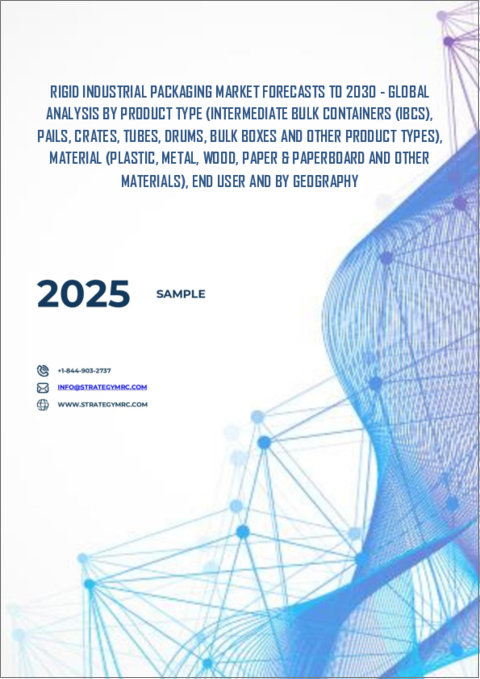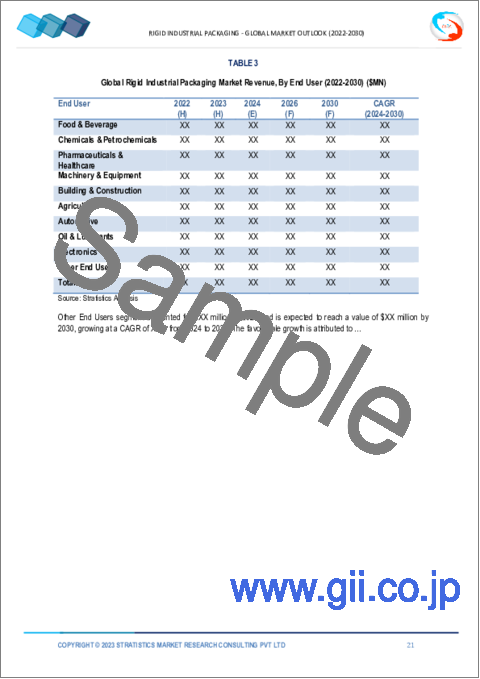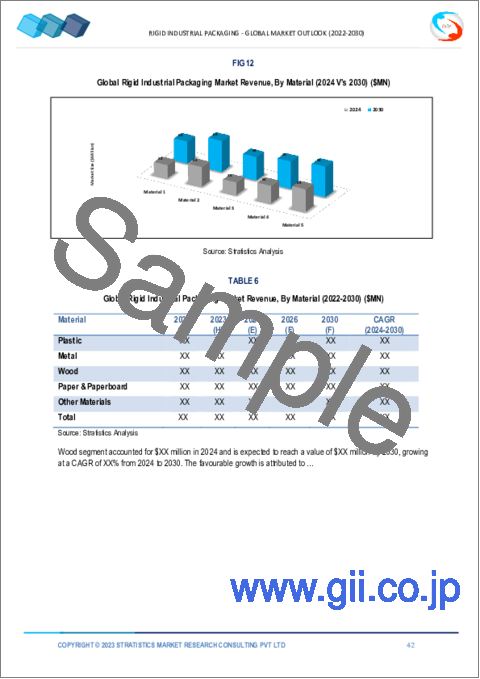|
|
市場調査レポート
商品コード
1551336
産業用硬質包装市場の2030年までの予測:製品タイプ別、材料別、エンドユーザー別、地域別の世界分析Rigid Industrial Packaging Market Forecasts to 2030 - Global Analysis by Product Type (Intermediate Bulk Containers, Pails, Crates, Tubes, Drums, Bulk Boxes and Other Product Types), Material, End User and By Geography |
||||||
カスタマイズ可能
|
|||||||
| 産業用硬質包装市場の2030年までの予測:製品タイプ別、材料別、エンドユーザー別、地域別の世界分析 |
|
出版日: 2024年09月06日
発行: Stratistics Market Research Consulting
ページ情報: 英文 200+ Pages
納期: 2~3営業日
|
全表示
- 概要
- 図表
- 目次
Stratistics MRCによると、世界の産業用硬質包装市場は2024年に343億米ドルを占め、予測期間中のCAGRは5.8%で成長し、2030年には482億米ドルに達する見込みです。
産業用硬質包装は、産業環境における物品の安全な輸送、保管、取り扱いのために設計された、耐久性があり柔軟性のない容器を指します。プラスチック、金属、ガラスなどの素材で作られたこれらのパッケージは、製品を損傷、汚染、環境要因から保護します。一般的な形状には、ドラム缶、樽、木箱などがあり、バルク材料、化学薬品、その他の頑丈な用途に使用され、安全で効率的な物流を保証します。
米国環境保護庁(EPA)によると、容器包装は2018年の都市固形廃棄物発生量に8,220万トンを占め、総発生量の約28.1%を占めました。
世界の工業生産の上昇
世界の工業生産の増加は、産業用硬質包装市場の重要な促進要因です。化学、医薬品、自動車など様々な分野で製造活動が増加するにつれて、堅牢で安全な包装ソリューションへの需要が高まっています。産業用硬質包装は、保管や輸送中に製品に必要な保護を提供し、その完全性と安全性を確保します。このような工業生産量の増加は、包装を必要とする商品の量の増加につながり、産業用硬質包装ソリューションの需要を直接押し上げ、市場の拡大に貢献します。
原材料価格の変動
原材料価格の変動は、産業用硬質包装市場の大きな抑制要因となっています。同市場はプラスチック、金属、紙などの原材料に大きく依存しており、これらはサプライチェーンの混乱、地政学的緊張、環境規制などの要因によって価格が変動します。こうした価格変動は、メーカーの生産コストや利益率に影響を及ぼし、エンドユーザーの価格上昇につながる可能性があります。また、こうした不安定さは長期的な計画や投資の決定に不確実性をもたらし、市場の成長を鈍化させる可能性もあります。
食品・飲料からの需要の増加
消費者の嗜好が簡便性と包装食品にシフトし、食品セクターにおけるeコマースの成長に伴い、堅牢で安全かつ持続可能な包装ソリューションに対するニーズが高まっています。産業用硬質包装は、賞味期限の延長、汚染からの保護、物流効率の向上といったメリットを提供します。この動向により、包装メーカーは食品・飲料業界特有の要件に合わせた専門的なソリューションを革新・開発できるようになり、市場の成長と多様化を促進しています。
サプライチェーンの混乱
自然災害、パンデミック、地政学的紛争などの世界の出来事は、包装材料や完成品の生産と流通に深刻な影響を与える可能性があります。こうした混乱は欠品、納品の遅延、コストの上昇につながり、バリューチェーン全体に影響を及ぼします。世界サプライチェーンは相互につながっているため、市場はこのような障害に対して脆弱であり、産業用硬質包装セクターの企業にとって、生産停止、顧客の喪失、財務的不安定を引き起こす可能性があります。
COVID-19の影響:
COVID-19パンデミックは当初、産業用硬質包装市場のサプライチェーンと製造工程を混乱させました。しかし、医薬品やeコマースなどの分野での需要も増加し、多少の損失は相殺されました。パンデミックは持続可能で衛生的なパッケージングソリューションへの動向を加速させ、長期的には製品開拓と市場戦略に影響を与えました。
予測期間中、食品・飲料セグメントが最大となる見込み
産業用硬質包装市場における食品・飲料セグメントの優位性は、いくつかの要因によってもたらされます。都市化の進展、消費者のライフスタイルの変化、包装食品や簡便食品への需要の高まりが、この分野の拡大に寄与しています。硬質包装は、汚染からの優れた保護、保存期間の延長、製品品質の維持を提供し、これらは食品・飲料産業において極めて重要です。さらに、食品の安全性と包装基準に関する厳しい規制が、産業用硬質包装ソリューションの採用をさらに後押ししています。
紙・板紙分野は予測期間中に最も高いCAGRが見込まれる
産業用硬質包装市場における紙・板紙セグメントのCAGRが高いのは、環境に対する関心の高まりと持続可能な包装ソリューションへのシフトに起因します。紙と板紙は再生可能で生分解性があり、リサイクルが容易であるため、環境に優しいパッケージングに対する消費者と規制当局の要求の高まりに合致しています。紙ベースの材料における技術革新は、その強度とバリア性を向上させ、より幅広い産業用途に適しています。紙ベースの硬質パッケージングソリューションの性能とコスト効率を向上させ、従来の素材との競争力を高める製造技術の進歩が、このセグメントの成長をさらに後押ししています。
最大のシェアを持つ地域
アジア太平洋の産業用硬質包装市場における優位性は、中国やインドなどの国々における急速な工業化、都市化、経済成長によってもたらされています。同地域では、特にエレクトロニクス、自動車、化学などの製造業が拡大しており、堅牢な包装ソリューションの需要を後押ししています。さらに、中流階級の人口増加と消費者の嗜好の変化が、硬質産業用パッケージングの主要なエンドユーザーである食品・飲料業界を後押ししています。同地域の世界・サプライチェーンにおける戦略的地位と製造拠点としての役割は、産業用硬質包装における同地域の市場リーダーシップにさらに貢献しています。
CAGRが最も高い地域:
アジア太平洋の産業用硬質包装市場のCAGRが高いのは、いくつかの要因によるものです。新興国における急速な工業化、外国直接投資の増加、製造業を促進する政府の取り組みが産業用包装の需要を促進しています。この地域の人口増加と可処分所得の増加は、特に食品・飲料分野での包装商品の消費を後押ししています。さらに、eコマースの拡大と効率的なロジスティクスソリューションの必要性が、硬質包装の技術革新を促進しています。この地域の持続可能な開拓への注力も、環境に優しい硬質包装ソリューションの採用を促進し、市場の成長をさらに加速させています。
無料のカスタマイズサービス
本レポートをご購読のお客様には、以下の無料カスタマイズオプションのいずれかをご利用いただけます:
- 企業プロファイル
- 追加市場企業の包括的プロファイリング(3社まで)
- 主要企業のSWOT分析(3社まで)
- 地域セグメンテーション
- 顧客の関心に応じた主要国の市場推計・予測・CAGR(注:フィージビリティチェックによる)
- 競合ベンチマーキング
- 製品ポートフォリオ、地理的プレゼンス、戦略的提携に基づく主要企業のベンチマーキング
目次
第1章 エグゼクティブサマリー
第2章 序文
- 概要
- ステークホルダー
- 調査範囲
- 調査手法
- データマイニング
- データ分析
- データ検証
- 調査アプローチ
- 調査情報源
- 1次調査情報源
- 2次調査情報源
- 前提条件
第3章 市場動向分析
- 促進要因
- 抑制要因
- 機会
- 脅威
- 製品分析
- エンドユーザー分析
- 新興市場
- COVID-19の影響
第4章 ポーターのファイブフォース分析
- 供給企業の交渉力
- 買い手の交渉力
- 代替品の脅威
- 新規参入業者の脅威
- 競争企業間の敵対関係
第5章 世界の産業用硬質包装市場:製品タイプ別
- 中間バルクコンテナ(IBC)
- ペール缶
- クレート
- チューブ
- ドラム
- バルクボックス
- その他
第6章 世界の産業用硬質包装市場:材料別
- プラスチック
- 高密度ポリエチレン(HDPE)
- ポリプロピレン(PP)
- ポリエチレンテレフタレート(PET)
- その他のプラスチック
- 金属
- 鋼鉄
- アルミニウム
- その他の金属
- 木材
- 紙・板紙
- その他
第7章 世界の産業用硬質包装市場:エンドユーザー別
- 食品・飲料
- 化学・石油化学製品
- 医薬品・ヘルスケア
- 機械・設備
- 建築・建設
- 農業
- 自動車
- オイルと潤滑油
- エレクトロニクス
- その他
第8章 世界の産業用硬質包装市場:地域別
- 北米
- 米国
- カナダ
- メキシコ
- 欧州
- ドイツ
- 英国
- イタリア
- フランス
- スペイン
- その他欧州
- アジア太平洋
- 日本
- 中国
- インド
- オーストラリア
- ニュージーランド
- 韓国
- その他アジア太平洋
- 南米
- アルゼンチン
- ブラジル
- チリ
- その他南米
- 中東・アフリカ
- サウジアラビア
- アラブ首長国連邦
- カタール
- 南アフリカ
- その他中東・アフリカ
第9章 主な発展
- 契約、パートナーシップ、コラボレーション、合弁事業
- 買収と合併
- 新製品発売
- 事業拡大
- その他の主要戦略
第10章 企業プロファイリング
- Amcor plc
- Berry Global Group Inc.
- Sonoco Products Company
- Silgan Holdings Inc.
- WestRock Company
- Greif Inc.
- Sealed Air Corporation
- DS Smith Plc
- Nefab Group
- International Paper
- Smurfit Kappa Group
- Mondi Group
- Pactiv LLC
- Georgia-Pacific Corporation
- Plastipak Holdings Inc.
- Tetra Pak International
- Bemis Company Inc.
- Reynolds Group Holding
List of Tables
- Table 1 Global Rigid Industrial Packaging Market Outlook, By Region (2022-2030) ($MN)
- Table 2 Global Rigid Industrial Packaging Market Outlook, By Product Type (2022-2030) ($MN)
- Table 3 Global Rigid Industrial Packaging Market Outlook, By Intermediate Bulk Containers (IBCs) (2022-2030) ($MN)
- Table 4 Global Rigid Industrial Packaging Market Outlook, By Pails (2022-2030) ($MN)
- Table 5 Global Rigid Industrial Packaging Market Outlook, By Crates (2022-2030) ($MN)
- Table 6 Global Rigid Industrial Packaging Market Outlook, By Tubes (2022-2030) ($MN)
- Table 7 Global Rigid Industrial Packaging Market Outlook, By Drums (2022-2030) ($MN)
- Table 8 Global Rigid Industrial Packaging Market Outlook, By Bulk Boxes (2022-2030) ($MN)
- Table 9 Global Rigid Industrial Packaging Market Outlook, By Other Product Types (2022-2030) ($MN)
- Table 10 Global Rigid Industrial Packaging Market Outlook, By Material (2022-2030) ($MN)
- Table 11 Global Rigid Industrial Packaging Market Outlook, By Plastic (2022-2030) ($MN)
- Table 12 Global Rigid Industrial Packaging Market Outlook, By High-Density Polyethylene (HDPE) (2022-2030) ($MN)
- Table 13 Global Rigid Industrial Packaging Market Outlook, By Polypropylene (PP) (2022-2030) ($MN)
- Table 14 Global Rigid Industrial Packaging Market Outlook, By Polyethylene Terephthalate (PET) (2022-2030) ($MN)
- Table 15 Global Rigid Industrial Packaging Market Outlook, By Other Plastics (2022-2030) ($MN)
- Table 16 Global Rigid Industrial Packaging Market Outlook, By Metal (2022-2030) ($MN)
- Table 17 Global Rigid Industrial Packaging Market Outlook, By Steel (2022-2030) ($MN)
- Table 18 Global Rigid Industrial Packaging Market Outlook, By Aluminum (2022-2030) ($MN)
- Table 19 Global Rigid Industrial Packaging Market Outlook, By Other Metals (2022-2030) ($MN)
- Table 20 Global Rigid Industrial Packaging Market Outlook, By Wood (2022-2030) ($MN)
- Table 21 Global Rigid Industrial Packaging Market Outlook, By Paper & Paperboard (2022-2030) ($MN)
- Table 22 Global Rigid Industrial Packaging Market Outlook, By Other Materials (2022-2030) ($MN)
- Table 23 Global Rigid Industrial Packaging Market Outlook, By End User (2022-2030) ($MN)
- Table 24 Global Rigid Industrial Packaging Market Outlook, By Food & Beverage (2022-2030) ($MN)
- Table 25 Global Rigid Industrial Packaging Market Outlook, By Chemicals & Petrochemicals (2022-2030) ($MN)
- Table 26 Global Rigid Industrial Packaging Market Outlook, By Pharmaceuticals & Healthcare (2022-2030) ($MN)
- Table 27 Global Rigid Industrial Packaging Market Outlook, By Machinery & Equipment (2022-2030) ($MN)
- Table 28 Global Rigid Industrial Packaging Market Outlook, By Building & Construction (2022-2030) ($MN)
- Table 29 Global Rigid Industrial Packaging Market Outlook, By Agriculture (2022-2030) ($MN)
- Table 30 Global Rigid Industrial Packaging Market Outlook, By Automotive (2022-2030) ($MN)
- Table 31 Global Rigid Industrial Packaging Market Outlook, By Oil & Lubricants (2022-2030) ($MN)
- Table 32 Global Rigid Industrial Packaging Market Outlook, By Electronics (2022-2030) ($MN)
- Table 33 Global Rigid Industrial Packaging Market Outlook, By Other End Users (2022-2030) ($MN)
Note: Tables for North America, Europe, APAC, South America, and Middle East & Africa Regions are also represented in the same manner as above.
According to Stratistics MRC, the Global Rigid Industrial Packaging Market is accounted for $34.3 billion in 2024 and is expected to reach $48.2 billion by 2030 growing at a CAGR of 5.8% during the forecast period. Rigid industrial packaging refers to durable, inflexible containers designed for the safe transport, storage, and handling of goods in industrial settings. Made from materials like plastic, metal, or glass, these packages protect products from damage, contamination, and environmental factors. Common forms include drums, barrels, and crates, which are used for bulk materials, chemicals, and other heavy-duty applications, ensuring secure and efficient logistics.
According to the United States Environmental Protection Agency (EPA), containers and packaging accounted for 82.2 million tons of municipal solid waste generation in 2018, which was approximately 28.1% of total generation.
Market Dynamics:
Driver:
Rise in global industrial production
The rise in global industrial production is a significant driver for the Rigid Industrial Packaging Market. As manufacturing activities increase across various sectors such as chemicals, pharmaceuticals, and automotive, the demand for robust and secure packaging solutions grows. Rigid industrial packaging provides the necessary protection for products during storage and transportation, ensuring their integrity and safety. This increased industrial output leads to a higher volume of goods requiring packaging, directly boosting the demand for rigid industrial packaging solutions and contributing to market expansion.
Restraint:
Volatility in raw material prices
Volatility in raw material prices poses a significant restraint on the rigid industrial packaging market. The market relies heavily on materials such as plastics, metals, and paper, which are subject to price fluctuations due to factors like supply chain disruptions, geopolitical tensions, and environmental regulations. These price variations can impact production costs and profit margins for manufacturers, potentially leading to higher prices for end users. This instability can also create uncertainty in long-term planning and investment decisions, potentially slowing market growth.
Opportunity:
Increasing demand from the food & beverage
As consumer preferences shift towards convenience and packaged foods, and with the growth of e-commerce in the food sector, there's a rising need for robust, safe, and sustainable packaging solutions. Rigid industrial packaging offers benefits such as extended shelf life, protection against contamination, and improved logistics efficiency. This trend allows packaging manufacturers to innovate and develop specialized solutions tailored to the unique requirements of the food and beverage industry, driving market growth and diversification.
Threat:
Supply chain disruptions
Global events such as natural disasters, pandemics, or geopolitical conflicts can severely impact the production and distribution of packaging materials and finished products. These disruptions can lead to shortages, delayed deliveries, and increased costs, affecting the entire value chain. The interconnected nature of global supply chains makes the market vulnerable to such disturbances, potentially causing production halts, loss of customers, and financial instability for companies in the rigid industrial packaging sector.
Covid-19 Impact:
The COVID-19 pandemic initially disrupted supply chains and manufacturing processes in the Rigid Industrial Packaging Market. However, it also increased demand in sectors like pharmaceuticals and e-commerce, offsetting some losses. The pandemic accelerated trends towards sustainable and hygienic packaging solutions, influencing product development and market strategies in the long term.
The food & beverage segment is expected to be the largest during the forecast period
The food and beverage segment's dominance in the rigid industrial packaging market is driven by several factors. Increasing urbanization, changing consumer lifestyles, and growing demand for packaged and convenience foods contribute to its expansion. Rigid packaging offers superior protection against contamination, extends shelf life, and maintains product quality, which are crucial in the food and beverage industry. Additionally, stringent regulations regarding food safety and packaging standards further propel the adoption of rigid industrial packaging solutions.
The paper & paperboard segment is expected to have the highest CAGR during the forecast period
The paper and paperboard segment's high CAGR in the rigid industrial packaging market is attributed to increasing environmental concerns and the shift towards sustainable packaging solutions. Paper and paperboard are renewable, biodegradable, and easily recyclable, aligning with growing consumer and regulatory demands for eco-friendly packaging. Innovations in paper-based materials have improved their strength and barrier properties, making them suitable for a wider range of industrial applications. The segment's growth is further driven by advancements in manufacturing technologies that enhance the performance and cost-effectiveness of paper-based rigid packaging solutions, making them increasingly competitive with traditional materials.
Region with largest share:
The Asia Pacific region's dominance in the rigid industrial packaging market is driven by rapid industrialization, urbanization, and economic growth in countries like China and India. The region's expanding manufacturing sector, particularly in electronics, automotive, and chemicals, fuels demand for robust packaging solutions. Additionally, the growing middle-class population and changing consumer preferences are boosting the food and beverage industry, a key end-user of rigid industrial packaging. The region's strategic position in global supply chains and its role as a manufacturing hub further contribute to its market leadership in rigid industrial packaging.
Region with highest CAGR:
The Asia Pacific region's high CAGR in the rigid industrial packaging market is attributed to several factors. Rapid industrialization in emerging economies, increasing foreign direct investments, and government initiatives promoting manufacturing sectors are driving demand for industrial packaging. The region's growing population and rising disposable incomes are boosting consumption of packaged goods, particularly in the food and beverage sector. Additionally, the expansion of e-commerce and the need for efficient logistics solutions are fueling innovations in rigid packaging. The region's focus on sustainable development is also driving the adoption of eco-friendly rigid packaging solutions, further accelerating market growth.
Key players in the market
Some of the key players in Rigid Industrial Packaging market include Amcor plc, Berry Global Group Inc., Sonoco Products Company, Silgan Holdings Inc., WestRock Company, Greif Inc., Sealed Air Corporation, DS Smith Plc, Nefab Group, International Paper, Smurfit Kappa Group, Mondi Group, Pactiv LLC, Georgia-Pacific Corporation, Plastipak Holdings Inc., Tetra Pak International, Bemis Company Inc., and Reynolds Group Holdings.
Key Developments:
In May 2024, Amcor, a global leader in developing and producing responsible packaging solutions, has expanded its packaging innovation hubs around the world. In addition to existing centers in the US, South America and Asia Pacific, the company has now opened its Amcor Innovation Center Europe (AICE) in Ghent, Belgium. The AICE will pioneer new material technologies to make packaging more sustainable and performant, while focusing on designs that stand out in shops and increase ease-of-use for consumers.
In April 2024, International Paper and DS Smith Plc announced that they have reached agreement on the terms of a recommended all-share combination, creating a global leader in sustainable packaging solutions. The terms of the Combination value each DS Smith share at 415 pence per share, and will result in IP issuing 0.1285 shares for each DS Smith share, resulting in pro forma ownership of 66.3% for IP shareholders and 33.7% for DS Smith shareholders, implying a transaction value of approximately $9.9 billion. The Combination is expected to close by the fourth quarter of 2024.
Product Types Covered:
- Intermediate Bulk Containers (IBCs)
- Pails
- Crates
- Tubes
- Drums
- Bulk Boxes
- Other Product Types
Materials Covered:
- Plastic
- Metal
- Wood
- Paper & Paperboard
- Other Materials
End Users Covered:
- Food & Beverage
- Chemicals & Petrochemicals
- Pharmaceuticals & Healthcare
- Machinery & Equipment
- Building & Construction
- Agriculture
- Automotive
- Oil & Lubricants
- Electronics
- Other End Users
Regions Covered:
- North America
- US
- Canada
- Mexico
- Europe
- Germany
- UK
- Italy
- France
- Spain
- Rest of Europe
- Asia Pacific
- Japan
- China
- India
- Australia
- New Zealand
- South Korea
- Rest of Asia Pacific
- South America
- Argentina
- Brazil
- Chile
- Rest of South America
- Middle East & Africa
- Saudi Arabia
- UAE
- Qatar
- South Africa
- Rest of Middle East & Africa
What our report offers:
- Market share assessments for the regional and country-level segments
- Strategic recommendations for the new entrants
- Covers Market data for the years 2022, 2023, 2024, 2026, and 2030
- Market Trends (Drivers, Constraints, Opportunities, Threats, Challenges, Investment Opportunities, and recommendations)
- Strategic recommendations in key business segments based on the market estimations
- Competitive landscaping mapping the key common trends
- Company profiling with detailed strategies, financials, and recent developments
- Supply chain trends mapping the latest technological advancements
Free Customization Offerings:
All the customers of this report will be entitled to receive one of the following free customization options:
- Company Profiling
- Comprehensive profiling of additional market players (up to 3)
- SWOT Analysis of key players (up to 3)
- Regional Segmentation
- Market estimations, Forecasts and CAGR of any prominent country as per the client's interest (Note: Depends on feasibility check)
- Competitive Benchmarking
- Benchmarking of key players based on product portfolio, geographical presence, and strategic alliances
Table of Contents
1 Executive Summary
2 Preface
- 2.1 Abstract
- 2.2 Stake Holders
- 2.3 Research Scope
- 2.4 Research Methodology
- 2.4.1 Data Mining
- 2.4.2 Data Analysis
- 2.4.3 Data Validation
- 2.4.4 Research Approach
- 2.5 Research Sources
- 2.5.1 Primary Research Sources
- 2.5.2 Secondary Research Sources
- 2.5.3 Assumptions
3 Market Trend Analysis
- 3.1 Introduction
- 3.2 Drivers
- 3.3 Restraints
- 3.4 Opportunities
- 3.5 Threats
- 3.6 Product Analysis
- 3.7 End User Analysis
- 3.8 Emerging Markets
- 3.9 Impact of Covid-19
4 Porters Five Force Analysis
- 4.1 Bargaining power of suppliers
- 4.2 Bargaining power of buyers
- 4.3 Threat of substitutes
- 4.4 Threat of new entrants
- 4.5 Competitive rivalry
5 Global Rigid Industrial Packaging Market, By Product Type
- 5.1 Introduction
- 5.2 Intermediate Bulk Containers (IBCs)
- 5.3 Pails
- 5.4 Crates
- 5.5 Tubes
- 5.6 Drums
- 5.7 Bulk Boxes
- 5.8 Other Product Types
6 Global Rigid Industrial Packaging Market, By Material
- 6.1 Introduction
- 6.2 Plastic
- 6.2.1 High-Density Polyethylene (HDPE)
- 6.2.2 Polypropylene (PP)
- 6.2.3 Polyethylene Terephthalate (PET)
- 6.2.4 Other Plastics
- 6.3 Metal
- 6.3.1 Steel
- 6.3.2 Aluminum
- 6.3.3 Other Metals
- 6.4 Wood
- 6.5 Paper & Paperboard
- 6.6 Other Materials
7 Global Rigid Industrial Packaging Market, By End User
- 7.1 Introduction
- 7.2 Food & Beverage
- 7.3 Chemicals & Petrochemicals
- 7.4 Pharmaceuticals & Healthcare
- 7.5 Machinery & Equipment
- 7.6 Building & Construction
- 7.7 Agriculture
- 7.8 Automotive
- 7.9 Oil & Lubricants
- 7.10 Electronics
- 7.11 Other End Users
8 Global Rigid Industrial Packaging Market, By Geography
- 8.1 Introduction
- 8.2 North America
- 8.2.1 US
- 8.2.2 Canada
- 8.2.3 Mexico
- 8.3 Europe
- 8.3.1 Germany
- 8.3.2 UK
- 8.3.3 Italy
- 8.3.4 France
- 8.3.5 Spain
- 8.3.6 Rest of Europe
- 8.4 Asia Pacific
- 8.4.1 Japan
- 8.4.2 China
- 8.4.3 India
- 8.4.4 Australia
- 8.4.5 New Zealand
- 8.4.6 South Korea
- 8.4.7 Rest of Asia Pacific
- 8.5 South America
- 8.5.1 Argentina
- 8.5.2 Brazil
- 8.5.3 Chile
- 8.5.4 Rest of South America
- 8.6 Middle East & Africa
- 8.6.1 Saudi Arabia
- 8.6.2 UAE
- 8.6.3 Qatar
- 8.6.4 South Africa
- 8.6.5 Rest of Middle East & Africa
9 Key Developments
- 9.1 Agreements, Partnerships, Collaborations and Joint Ventures
- 9.2 Acquisitions & Mergers
- 9.3 New Product Launch
- 9.4 Expansions
- 9.5 Other Key Strategies
10 Company Profiling
- 10.1 Amcor plc
- 10.2 Berry Global Group Inc.
- 10.3 Sonoco Products Company
- 10.4 Silgan Holdings Inc.
- 10.5 WestRock Company
- 10.6 Greif Inc.
- 10.7 Sealed Air Corporation
- 10.8 DS Smith Plc
- 10.9 Nefab Group
- 10.10 International Paper
- 10.11 Smurfit Kappa Group
- 10.12 Mondi Group
- 10.13 Pactiv LLC
- 10.14 Georgia-Pacific Corporation
- 10.15 Plastipak Holdings Inc.
- 10.16 Tetra Pak International
- 10.17 Bemis Company Inc.
- 10.18 Reynolds Group Holding






